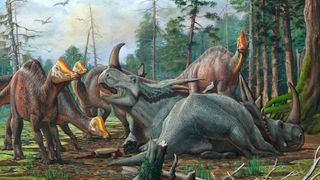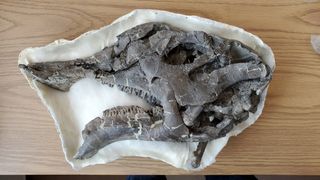Teenage duck-billed dinosaurs struck out on their own, forming cliques
Juvenile duck-billed dinosaurs likely hung out in cliques, away from their original herd, an analysis of two bonebeds reveals.

Teenage duck-billed dinosaurs broke off from the herd — essentially saying "See you later!" to older and younger paleo-pals — and traveled together in cliques, new research suggests.
Paleontologists made the discovery after studying two North American bonebeds that held the fossilized remains of the duck-billed dinosaur Hypacrosaurus stebingeri, also known as a hadrosaur. These herbivorous dinosaurs lived during the late Cretaceous period around 75 million years ago.
By studying dinosaurs in the bonebeds that died at different life stages, such as juvenile or adult, researchers found that "young individuals left the herd at some point in their life," likely when they reached about 45% of their maximum size as mature adults, Tristan Joubarne, a graduate student in the Department of Geoscience at the University of Calgary, told Live Science in an email.
"We now have a better understanding of the herding behavior and life history of this dinosaur," Joubarne said. The research, which was presented Nov. 4 at the Society of Vertebrate Paleontology's annual conference in Toronto, is not yet published in a peer-reviewed journal.
Related: Jurassic graveyard reveals oldest evidence that dinosaurs traveled in herds
Although hadrosaurs are among the most common dinosaurs in the fossil record and were "like the cows or deer of the Late Cretaceous," little is known about their behavior, Joubarne said. That's why he investigated bonebeds; these piles of fossilized bones can occur because a group of animals died together at the same time, which means the site may provide clues about how they interacted with each other.

One bonebed, found in Devil's Coulee in southern Alberta in the late 1980s, had bones from at least four individuals. The other, discovered in the Two Medicine Formation in northwestern Montana, had bones from at least three smaller individuals. Both bonebeds were excavated and are now housed at the Royal Tyrrell Museum of Palaeontology in Alberta. An analysis by Joubarne and colleagues revealed that the dinosaurs in each bonebed died at the same time, meaning that they had likely lived together in groups.
Sign up for the Live Science daily newsletter now
Get the world’s most fascinating discoveries delivered straight to your inbox.
Joubarne was on the lookout for juvenile hadrosaurs. Prior research has revealed that H. stebingeri reached adulthood at around 10 years of age and lived until at least age 13. Fully grown individuals had a large crest atop their heads and measured up to 33 feet (10 meters) long.
The hadrosaurs in the two bonebeds were about half that size or smaller. The smallest individuals lacked a crest, and the largest ones were just starting to grow one, indicating that "these dinosaurs were not mature, and they still had a long way to go before they reached adulthood," Joubarne said. The Alberta specimens were all around the same age, while the hadrosaurs in the Montana bed varied in size and were likely different ages, he said.
Taken together, "these bonebeds suggest that very young individuals of Hypacrosaurus stebingeri lived together in a group with individuals of various ages for a few years, possibly within a herd," Joubarne said. "Then when they reached a certain size, they left the group and lived exclusively with individuals of their own age."
One explanation for this age segregation is that they formed their own herd when approaching sexual maturity, Joubarne said. But that needs to be confirmed in more bonebeds, he said.
Scientists have long suspected that juvenile hadrosaurs lived in age-segregated cliques, but there has been little evidence to support it, said Kirstin Brink, an assistant professor in the Department of Earth Sciences at the University of Manitoba in Canada who was not involved in the research.
The new study provides compelling evidence for this hypothesis, Brink told Live Science in an email. The bonebeds also raise a question about why these juvenile hadrosaurs lacked well-developed cranial crests, Brink said.
"Were they used for signalling sexual maturity? Did the social structure change once they reached sexual maturity?" Brink said. "Studies like this will help shed light on the function of those crests."

Laura is the archaeology and Life's Little Mysteries editor at Live Science. She also reports on general science, including paleontology. Her work has appeared in The New York Times, Scholastic, Popular Science and Spectrum, a site on autism research. She has won multiple awards from the Society of Professional Journalists and the Washington Newspaper Publishers Association for her reporting at a weekly newspaper near Seattle. Laura holds a bachelor's degree in English literature and psychology from Washington University in St. Louis and a master's degree in science writing from NYU.
Most Popular

